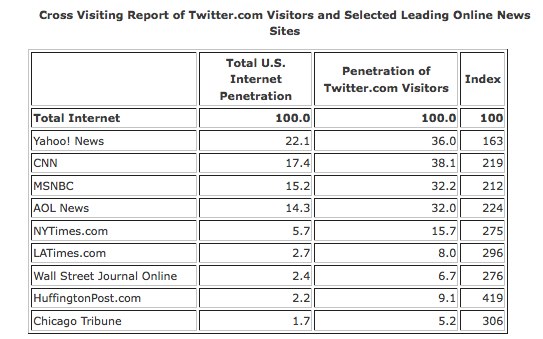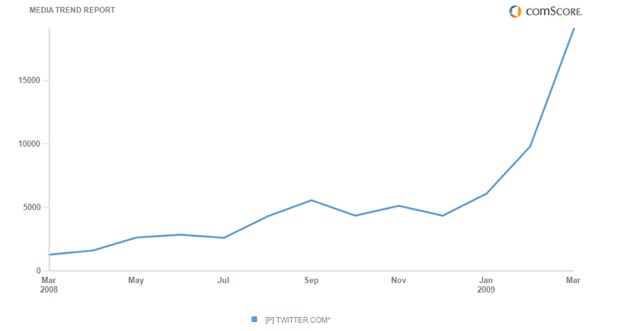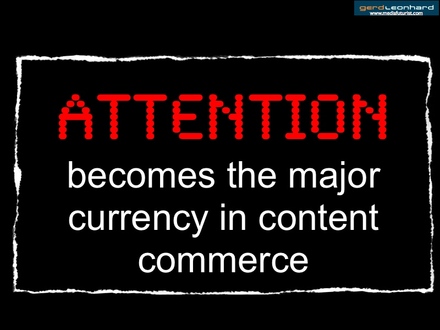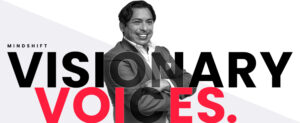Following the solo media vs. traditional media race that led Twitter into both relevance and irrelevance, the result is that the carefully guarded community and its unique culture are now permanently altered – for better or for worse.
According to estimates sourced by Engadget Editor-in-Chief Ryan Block, Twitter grew by 1.2 million users simply as a result of the “Oprah-effect.”
TechCrunch’s MG Siegler also explored the process for estimating Twitter’s path into the mainstream.
What does 1.2 million new users mean for Twitter?
So, how many new users really joined Twitter as a result of the celebrity-fueled popularity contest?
I’m not sure the answer truly matters. If we explore it from a sociological perspective, I believe that the culture of Twitter has been introduced to a significant event that may indeed shift interaction and behavior overall.
Going into the race, estimates pegged the active userbase anywhere between 5 – 8 million. Now post race and the Oprah-effect, over 1 million people were introduced to the service guided by a “follow me” mentality. This “overnight” expansion represents a potential 10-12% saturation ratio. These new users will participate and build communities around them based on their interpretation of the network as framed by those whom they follow. Remember, we are measured by our last 20 tweets or updates within each social network. Take a look for yourself, www.twitter.com/insertusername
It is what it is. The real question is, what do you want to get out of these connections?
In the end, we are still responsible for creating our own experience within the community and that is one of the true advantages and rewards of Twitter. We foster and cultivate individual ecosystems that bind us contextually.
Competing for Attention
Perhaps what is most interesting and prevalent is the behavior transformation in content consumption that is taking place in “Twitter time” and it’s establishing a new world authority. For many of us, we’re migrating away from destinations and potentially RSS readers as well as our primary source of news, relevant information, pleasant distractions, and trending topics. We’re quickly focusing on Twitter, Facebook News Feeds, FriendFeed and the statusphere as our highly curated and personalized attention dashboards.
As content publishers, producers, and creators, we need to acknowledge, understand, and embrace this critical disruption.
Let’s take a look at Twitter as an example. Before the April’s madness of follower contests, Comscore reported that Twitter had experienced a new record of 9.3 million visitors in March, which represented a 131% jump.
As you can see, the growth curve is practically vertical. And, we’re sure to see yet another surge in growth when April numbers are released.
However, Comscore is also observing what I believe to represent the hope and potential future for traditional media.
When they examined the percentage of visitors to Twitter who also visited the top online news brands and compared it to that of the total U.S. Internet audience, they discovered a strong level of overlap. The result is that the average Twitter user was often 2 and 3 times as likely to visit the top online news brands as the average person. For example, while 17 percent of the total U.S. Internet audience visited CNN.com in March, more than double that percentage (38 percent) of Twitter users did so.

Twitter, Facebook, FriendFeed and active online social interaction breathe new, and measurable, life into great content where it’s hosted, simply by connecting it to the potentially attentive people where and how they are currently engaged.
This is the Statusphere, a new ecosystem for sharing, discovering, and publishing updates and micro-sized content that reverberates throughout social networks and syndicated profiles, resulting in a formidable network effect of viral activity. It is the digital curation of relevant content that binds us contextually and through the statusphere we can connect directly to existing contacts, reach new people, and also forge new friendships through the friends of friends effect (FoFs) in the process.
In order to compete for prominence in the future, we must first compete for attention where and when it’s captivated. While we contribute to the evolution of new media and the supporting cultures within each network, we are responsible for what we contribute and what we gain from the interaction. We earn the relationships we deserve.
Update: comScore released global numbers that show a worldwide surge of 19.1 million visitors in March 2009.

Helpful Posts on PR 2.0:
– Online Reputation and Brand Management Starts with Identity
– The Social OS, The Battle Between Facebook and Twitter is the New Mac vs. PC
– The Domino’s Effect
– The Conversation Index
– A New Search Engine for Twitter
– Social Media Influences Buying Decisions
– Is Social Media Recession Proof?
– Facebook Now 200 Million Strong
– Twitter Traffic Surges to 10 Million
– The End of the Innocence
– The Social Effect and Disruption Theory
– Putting the Public Back in Public Relations is Now Available
– Twitter and Social Networks Usher in a New Era of Social CRM
– The Human Network = The Social Economy
– In the Statusphere, ADD Creates Opportunities for Collaboration and Education
– Humanizing Social Networks, Revealing the People Powering Social Media
– Social Networks Now More Popular than Email; Facebook Surpasses MySpace
– I Like You The Emerging Culture of Micro Acts of Appreciation
– The Ties that Bind Us – Visualizing Relationships on Twitter and Social Networks
– Make Tweet Love – Top Tips for Building Twitter Relationships
– The Battle for Your Social Status
– Twitter Tools for Communication and Community Professionals
– Is Twitter a Viable Conversation Platform
Connect with me on:
Twitter, FriendFeed, LinkedIn, Tumblr, Plaxo, Plurk, Identi.ca, BackType, Social Median, or Facebook
—
Subscribe to the PR 2.0 RSS feed.
![]()
—
Now available:


—
pr pr+2.0 pr2.0 public+relations marketing advertising interactive social+media socialmedia brian+solis social media media2.0 media+2.0 2.0 smo social+media+optimization marcom communication publicity twitter facebook friendfeed twitter+bomb viral social+effect effect ashton+kutcher oprah tweet status statusphere attention economy reporter journalism journalist content writer blogger blog authority newspaper social+economy attention+economy







If that’s true (it’s not) why doesn’t @oprah have 1.2 million of her own followers (she got at least 300,000 by being on the recommended follower list, not organically). As of this writing she only has 530,000 followers. So, if she brought 1.2 million in, why don’t they all follow HER? Hint: she didn’t bring in nearly that many.
Twitter is responsible for a 50% traffic increase on our blog. Thanks Brian, great article.
http://www.pickedbyguys.com
Robert Scoble, maybe this is true. Not everyone that was watching Oprah at that moment really actually cares about her, or care but realize that giving their attention to her 27/7 via twitter might be too painful to handle. Also, How many could be zapping? Now, what I believe to be the most important factor… it’s not just oprah… it’s the opra effect – meaning: it generated tons of buzz in other medias (both mainstream and small channels, online and off) and it generated tons of word of mouth via friends of people who watched it, friends who read the post, heard the news, etc. When it reached this point, definitely not everyone who heard about it because of the oprah effect cares about oprah. So thats why she doesnt have to have created 1,2million users to have created the adoption people estimate it did.
This post is great, and recently (yesterday) I wrote about other topics covered here in our blog (see link on my name), and what I most strongly agree is that relevance is going to become a definite must, and a very scarce commodity. People won’t handle following tons of people broadcasting “next to useless info”. It would kill the whole purpose of creating a new world where we only listen and absorb what we really want to, and need.
Our blog is a month old, and I can say, like Phil just said, that not only 50% but about 90% from our traffic comes from tweets and RTs. =)
Cheers everyone, great post Brian, thanks!
If celebrities and their popularity-fueled followers are increasing their share of the Twitter user base, what's the risk:
1. that Twitter's prevailing cultural sociology of behavior and interactions (that we've come to know and enjoy) becomes "mainstreamed" by the clutter of fandom and the din of "irrelevance?"
2. that Twitter's pioneering early adopters, the followers they formed, and the countless other users who share in the community's prevailing culture of creating & collaborating and belonging & bonding simple vacate the space all-together?
Regarding your interesting observation that Twitter users are increasing their reader share in online traditional media networks, I have a feeling it's more of a hollow solace for their owners/shareholders. The fact is, what these traditional media properties need are opportunities to earn revenues off of fee-based content, and Twitter traffic will not monetize for them. Oh well…what will they do to survive?
Brian, always good to comment on your insight.
Well, one thing I know as a new user of Twitter, it makes your followers to read ur updates and through the links mentioned during each tweets, u get good number of hits…this is a revolutionary road for Twitter…its a boon for many media people and the PR people..its a new form of media..and it has got its own share of popularity both through negative and positive ways…so people are now all the more interested in getting in to..Twitter!!
It has already distabilised the email mode of communication and now it is very quickly entering into the mainstream media as well..as you have highlighted quite nicely the post!!
As our lives are increasingly consumed by Facebook pages, IM, Twitter, RSS feeds, Digg Thumbs Up’s, url shorteners, embedded HTML, emoticons and hyperlinks, there is little doubt about the premium placed on timely information. It has reached a point where the value of information seemingly diminishes in direct proportion to how old it is. As if an article written six months ago might well as be ten years old.
This tendency will only increase as we hurtle towards a real-time web. FriendFeed has launched the world’s first real-time, live streaming, social media service that is set to revolutionize all media. Yet as people constantly and seamlessly update their “lifestream”, I wonder about the role of meaningful communication?
The funny – and yes timely – Flutter April Fools joke (below) parodied our growing obsession with instantaneous information, exposing the growing misunderstanding that the newness of a means of communication automatically makes that communication meaningful.
The important distinction, as Zeus Jones points out, is that while real time information loses value over time, timeless pieces grow in value.
When you consider brands also rely on an emotional connection with their customers to motivate their behavior, this confusion can be costly. Of course, a meaningful connection isn’t always timeless but the same limitations apply. Hoping to generate trust, interest or loyalty in 140 characters alone is as misguided as a guy wheeling out his best one-liner at a bar. Brands must use a composite of media to build an effective relationship with their customers, rather than see social media as an end in itself. Even when a brand, its products or social entrepreneurship becomes the focal point for conversation it must also play the overarching role of “aggregator and curator”, as Joseph Jaffe asserts, “to provide a place where consumers can see the conversations pulled together, engage with the brand, hear the story in the brand’s voice”.
A means of communication is not an end in itself. It exists to create a connection that enables us to recognize ourselves in others. If our daily exchanges are reduced to a teeming sea of quips, asides and blunt reductions, we simply enlist ourselves in the service of data tracking. As if our lives were some enormous marketing focus group and our communication ticks for empty boxes.
When communication becomes a shooting gallery, the first casualty is dialogue that adds meaning to our lives. As both marketers and consumers, we would be foolish to let this happen.
I’m not sure Oprah personally brought in 1.2 million people, but you can bet she brought a band of celebrities who brought those people– and more– with them.
I’ve noticed a shift in the quality of people following me. With the popularity comes the bots and those trying to exploit the space. And this, I think, is what will affect Twitter as a social media space. How potent will the conversation be now that it’s being diluted by millions of phantom accounts? Maintaining your list of followers will be crucial to sustaining this space.
Brian,
Thank you for this post and for the great content you share in your blog.
I wanted to briefly share our own thinking related to acquiring attention amidst the overwhelming number of competitors. At WordWrite Communications (http://www.wordwritepr.com), we focus on telling the great, untold stories of our clients. This has led us to develop StoryCrafting, our own process for helping organizations to create, develop and share their great, untold story. We focus on three things: developing the authentic stories of our clients, identifying the fluent storytellers in the organization who can tell those stories, and helping our clients to constantly “read the audience” to assure that real dialogue, and thus, real communication, is occurring, when the stories are told.
We very much would like to expand the dialogue on StoryCrafting, and for that reason, I invite you and your readers to take a look at our new white paper on this topic (http://www.wordwritepr.com/pdf/storycrafting_white_paper.pdf) and also our blog, which shares additional background and ideas on these topics (http://www.wordwritepr.com/blogstorytelling/).
y7Mk1x cubstqtoifte, [url=http://cnxwvmgkdwqr.com/]cnxwvmgkdwqr[/url], [link=http://aqlrhyagluyq.com/]aqlrhyagluyq[/link], http://pgwdaxgzwhqf.com/
Well , the view of the passage is totally correct ,your details is really reasonable and you guy give us valuable informative post, I totally agree the standpoint of upstairs. I often surfing on this forum when I m free and I find there are so much good information we can learn in this forum!
multi-cavity